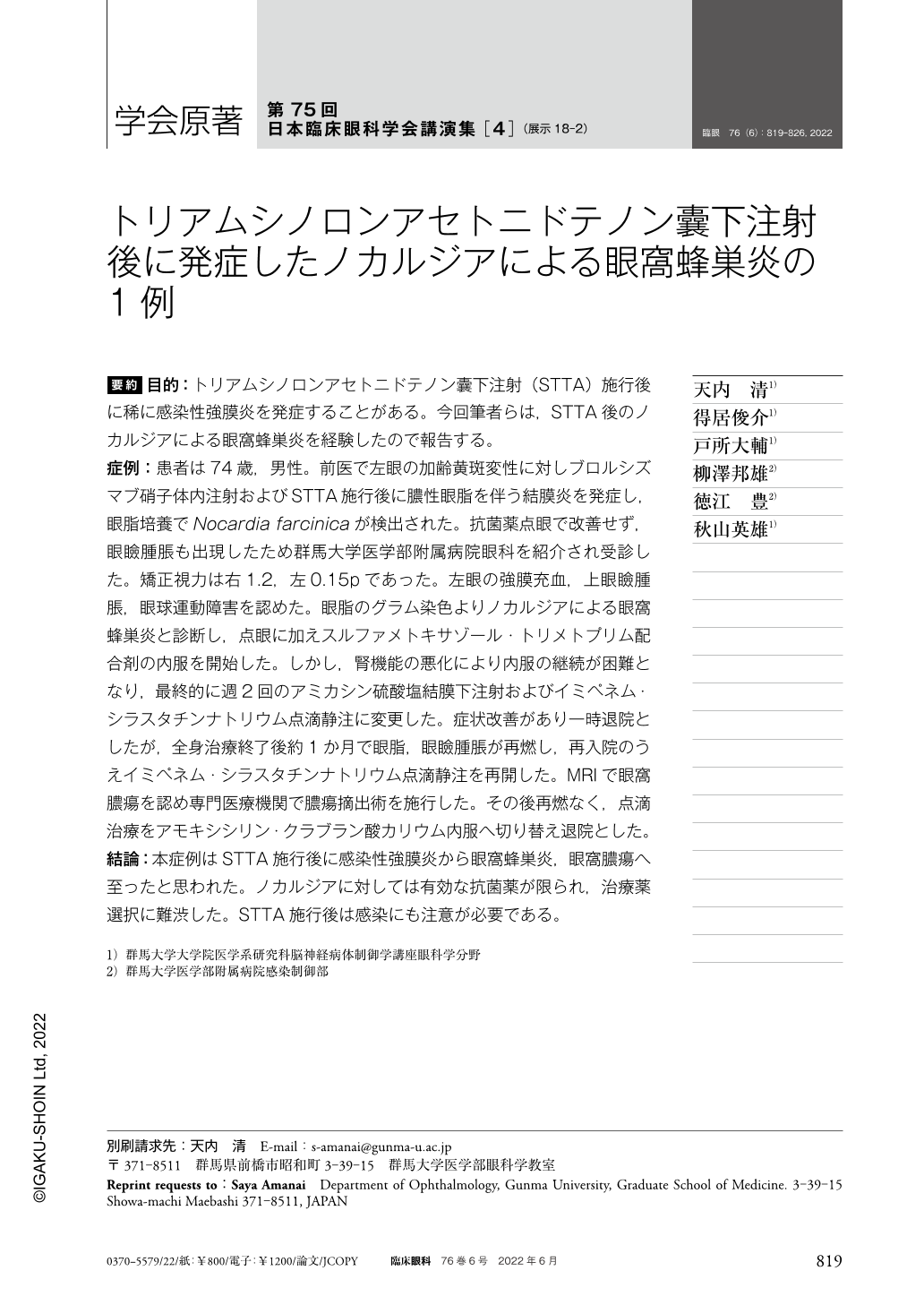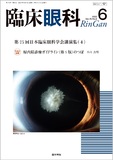Japanese
English
- 有料閲覧
- Abstract 文献概要
- 1ページ目 Look Inside
- 参考文献 Reference
要約 目的:トリアムシノロンアセトニドテノン囊下注射(STTA)施行後に稀に感染性強膜炎を発症することがある。今回筆者らは,STTA後のノカルジアによる眼窩蜂巣炎を経験したので報告する。
症例:患者は74歳,男性。前医で左眼の加齢黄斑変性に対しブロルシズマブ硝子体内注射およびSTTA施行後に膿性眼脂を伴う結膜炎を発症し,眼脂培養でNocardia farcinicaが検出された。抗菌薬点眼で改善せず,眼瞼腫脹も出現したため群馬大学医学部附属病院眼科を紹介され受診した。矯正視力は右1.2,左0.15pであった。左眼の強膜充血,上眼瞼腫脹,眼球運動障害を認めた。眼脂のグラム染色よりノカルジアによる眼窩蜂巣炎と診断し,点眼に加えスルファメトキサゾール・トリメトプリム配合剤の内服を開始した。しかし,腎機能の悪化により内服の継続が困難となり,最終的に週2回のアミカシン硫酸塩結膜下注射およびイミペネム・シラスタチンナトリウム点滴静注に変更した。症状改善があり一時退院としたが,全身治療終了後約1か月で眼脂,眼瞼腫脹が再燃し,再入院のうえイミペネム・シラスタチンナトリウム点滴静注を再開した。MRIで眼窩膿瘍を認め専門医療機関で膿瘍摘出術を施行した。その後再燃なく,点滴治療をアモキシシリン・クラブラン酸カリウム内服へ切り替え退院とした。
結論:本症例はSTTA施行後に感染性強膜炎から眼窩蜂巣炎,眼窩膿瘍へ至ったと思われた。ノカルジアに対しては有効な抗菌薬が限られ,治療薬選択に難渋した。STTA施行後は感染にも注意が必要である。
Abstract Purpose:Infectious scleritis may occur rarely after subtenon triamcinoloneacetonide(STTA)injection. The purpose of this article is to report a case of orbital cellulitis caused by Nocardia farcinica after STTA injection.
Case:A 74-year-old man with age-related macular degeneration in his left eye received injections of intravitreal brolucizumab and STTA by his previous doctor. After injections, he developed conjunctivitis with a purulent discharge, and N. farcinica was identified from the discharge culture. The patient was referred to us since his conjunctivitis did not improve despite 3 months of treatment with topical antibiotics eyedrops, and also because he further developed eyelid swelling. At the first visit, his best corrected visual acuity(decimal)was 1.2 in the right eye and 0.1 in the left eye. The patient had a history of scleral injection, eyelid swelling, and restricted eye movement in the left eye. We diagnosed a case of nocardial orbital cellulitis based on the result of Gram staining and then started oral administration of sulfamethoxazole/trimethoprim in addition to eyedrops. However, continuation of the sulfamethoxazole/trimethoprim treatment was found to be difficult due to renal dysfunction, and therefore we eventually decided to change the treatment to subconjunctival amikacin injection and systemic imipenem/cilastatin intravenous injection. The patient was once discharged due to improvement in eyelid swelling. However, as the patient's eyelid swelling recurred approximately one month later, he was readministered in our hospital and again received systemic imipenem/cilastatin administration. MRI revealed orbital abscess and we referred the patient to a specialized medical institutions for abscess excision. Eyelid swelling improved after the abscess excision. The patient was discharged with oral administration of amoxicillin-clavulanate acid.
Conclusion:We believe that STTA injection induced infections and scleritis by N. farcinica, which was followed by orbital cellulitis and orbital abscess. We experienced difficulty in selecting therapeutic agents because there are only a limited number of effective antibiotics. Therefore, clinicians should be aware of infections occuring after STTA injections.

Copyright © 2022, Igaku-Shoin Ltd. All rights reserved.


